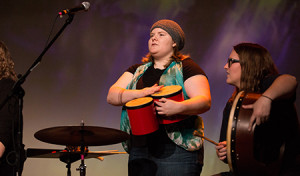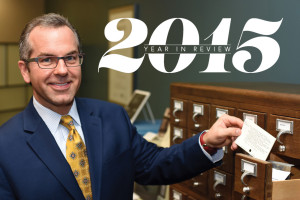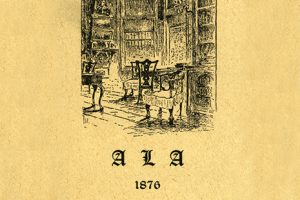
“Bugs!” the 1st-grader at St. Paul’s Lutheran School shouted enthusiastically. No, we weren’t in the middle of an entomology lesson. I was giving a demonstration on the didgeridoo, using the actual instrument from the Vogel Library World Music Instrument Collection at Wartburg College in Waverly, Iowa.
The answer, to be more precise than that 1st-grader, is “termites,” and the question was, “What hollows out the branch of the eucalyptus tree used to make the didgeridoo?” It’s one of the most organic world-music instruments around and easily one of the best known. The 1st-graders had just finished a unit on Australia, and their student teacher, a music education major at Wartburg College, suggested I visit to show them a real example from that culture.
That visit was one of several excursions I used to advertise the library’s World Music Instrument Collection in its first year (academic year 2013–2014). The collection grew out of a desire to serve two kinds of students: those studying ethnomusicology and those studying for a music therapy degree. There was a third population I hoped to serve—the Wartburg student body as a whole. The college has a substantial international student population and a healthy study-abroad program, but when they are here in the US or unable to enroll in one of the travel courses, the students do not have immediate access to music from other cultures.

At Wartburg, we are lucky to have renowned ethnomusicologist Maria Paula Survilla (also the executive director of the Center for Belarusian Studies at Southwestern College in Winfield, Kansas) and Melanie Harms (director of our music therapy programs) on our faculty. In collaborating with both of these professors to teach information literacy skills and concepts, I knew that a collection of world music instruments would benefit the deep, integrative learning goals to which Wartburg aspires.
Libraries have been branching out to loan nontraditional collections for the past several years, from seed packets to walkers, and our own library offers a bicycle-loaning program. But no academic libraries that I could locate had an active world-instrument collection meant for casual borrowing purposes. Once I created the collection, with input from Survilla and Harms, I heard Kristie Nelsen, from the Anchorage (Alaska) Public Library system, speak at the 2014 Music Library Association (MLA) annual meeting about her library’s foray into loaning ukuleles. Although that collection is at a public library, it consists of only one type of instrument, and the intended patron base is primarily children, the similar purpose—music without borders—is encouraging because it shows that an instrument collection can benefit more than one type of library.
There are many reasons to consider starting your own instrument-loaning program. Benefits include:
Bridging the socioeconomic divide. It’s not news that those born into lesser economic circumstances do not have the same opportunities for cultural education. Libraries already have a strong commitment to bridging this divide in reading readiness and access to resources. Adding musical instruments to the borrowing collection is another way to provide wider access to items that can spark youthful curiosity and enhance a student’s academic success.

Bridging the geographic divide. I attended college in the Twin Cities in Minnesota, where I had my pick of cultural music events. Wartburg College, however, is located in northeast Iowa—a great place for fresh air, bike trails, farmer’s markets, and microbrews, but not quite a hotbed of world music festivals. Providing tangible examples of other cultures’ musical heritages is a great way to travel when you are prairie-bound. Even if you live in a large city, you can still remain open to stretching past your region.
Bridging the cultural divide. What better way to combat the unfortunate stereotype of the culturally clueless American than to add instruments of other cultures to your collection? At Wartburg, this was particularly useful for our music therapy students. Each student chose a world instrument to research and use in developing therapy plans over the course of one semester. What they found was that incorporating world music into music therapy practice gave them more options and, more importantly, provided an opportunity to connect with patients from non-Western musical cultures.
In searching for guidelines for this unusual collection, I found that there was not much precedent—if universities had world instrument collections, they were often housed in the music department and not for public loan. The librarians I spoke with from the MLA World Music Round Table expressed concern that maintaining such a fragile collection could be difficult. Just as there are many reasons to create an instrument collection, there are many aspects to consider once you do. The following suite of considerations is a good start.
Match your patrons’ needs to your library’s goals. Consider your community demographics. For our collection, the students who use these instruments in coursework have specific disciplinary outcomes that mesh well with the Vogel Library mission of creating information-literate, lifelong learners. This means we could choose a wide variety of instruments. Your population may express a need for only one instrument or one culture’s instrument—but don’t be afraid to interpret your library’s goals as supporting serendipitous discovery.

Harmonize your maintenance abilities. Consider the level of difficulty required to maintain the instruments. Can parts be glued? Can the instrument be left idle for several years? Will you need to know how to tune, restring, or use rosin? And what level of knowledge will staff members need in order to educate patrons on the instruments? I play three instruments, I have a wealth of music students and faculty at my disposal, and I have access to the music department’s own instrument repair shop, so in Vogel Library’s case, the concern over maintenance is low—but yours may be very different.
Another aspect of maintenance is cleanliness. Aerophones (wind or brass instruments), for example, will need to be disinfected thoroughly between each use, a process which ranges from simple to complex, depending on the instrument. Consider how much staff time is available for these tasks.
A third aspect of maintenance is budget allocation. Do funds exist for ongoing maintenance, including replacement costs and collection expansion? You may need to deliberate further if you have funds to begin a collection but none to continue it.
Clarify patron responsibility and access. With more traditional loaned items, patron responsibilities are usually well understood. With nontraditional items, I recommend establishing an explicit policy. Even if you purchase $10 ukuleles and decide to replace them any time they are broken, a patron-responsibility policy can still save you later headaches. In other scenarios, you may want a stricter policy and choose to have patrons sign a form accepting responsibility upon checkout. I created a form that students sign the first time they borrow an instrument. We keep the form on file; it states that the student is responsible for the full cost of the instrument if broken or lost irresponsibly—but the student is not responsible for no-fault issues such as a broken string or existing defects.
If repetitive damage is expected, you may want to limit access to the instruments. Since my goal was to bridge several types of divides, I didn’t want to limit access. Thus, any patron—including community patrons—can borrow the instruments for an allotted time. Your library may need different guidelines based on your particular concerns.
Respect cultural boundaries. Some instruments are a sacred part of a culture—whether it is that only a certain kind of person may play an instrument, or an instrument is only played during a certain time of year—and you should consider whether an instrument you are collecting has cultural boundaries that would compromise its ability to be loaned. In other circumstances, an instrument’s original boundaries may have become diluted over the years and after its migration to other countries. Consider all these aspects carefully before making your choices.
Once you’ve considered all benefits and weighed the costs, I hope you decide that a world-music instrument collection can be an invigorating addition to your library. For more information about the Vogel Library World Music Instrument Collection, see our LibGuide on the collection or contact me at jill.westen@wartburg.edu.

 JILL WESTEN is an information literacy librarian at Wartburg College and a writer who gardens in Waverly, Iowa. Her interest in world music extends to a passion for Bollywood movies, which you can see in her blog
JILL WESTEN is an information literacy librarian at Wartburg College and a writer who gardens in Waverly, Iowa. Her interest in world music extends to a passion for Bollywood movies, which you can see in her blog 
